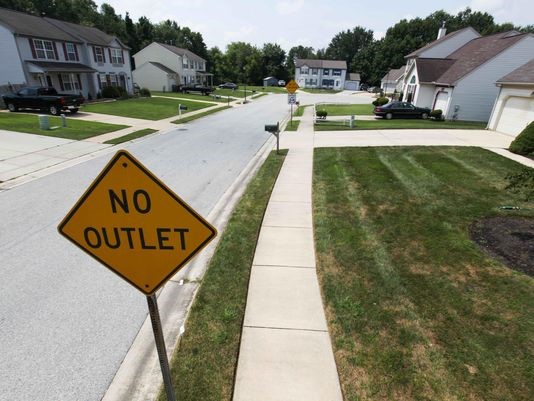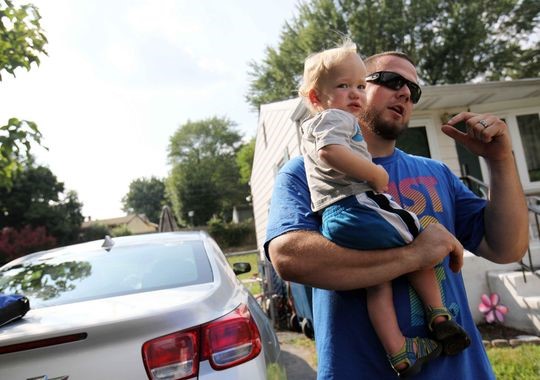Contact - Volunteer - Contribute - (302) 468-6024

|
||||||||||||||||||||||||||
| Bob Weiner News | ||||||||||||||||||||||||||
|
7/29/2015 Road planners want to link the streets of New Castle County's suburban communities to nearby neighborhoods with bike and pedestrian lanes, said Drew Boyce, planning director at the Delaware Department of Transportation. "We're looking at opportunities where we can knit those [neighborhoods] together for bike and [pedestrian] connections," Boyce said. "Even though there's not enough space for an actual road connection, sometimes there's enough of community open space between the lots [for a trail]." Connect Delaware suburbs, planners sayKarl Baker and Xerxes WIlson, The News Journal 9:13 p.m. EDT July 29, 2015 Clearview Court in the Kenmore neighborhood ends in a cul-de-sac. Delaware Department of Transportation planners hope to connect one-entrance communities like this one in the northern part of the state with bike and pedestrian trails.(Photo: DANIEL SATO/THE NEWS JOURNAL) Proposals to open some of northern Delaware's isolated "cul-de-sac communities" to bike and pedestrian trails have many residents nervous about who will be cutting through their backyards and side streets. Road planners want to link the streets of New Castle County's suburban communities to nearby neighborhoods with bike and pedestrian lanes, said Drew Boyce, planning director at the Delaware Department of Transportation. "We're looking at opportunities where we can knit those [neighborhoods] together for bike and [pedestrian] connections," Boyce said. "Even though there's not enough space for an actual road connection, sometimes there's enough of community open space between the lots [for a trail]." But many people moved into these older developments, where there is often only one road in, because of the seclusion and sense of safety they offered. "An actual bike trail, I don't know if I'd feel comfortable," said Carla Asbury, a nursing student who lives in the Caravel Farms neighborhood near Glasgow, where DelDOT has proposed a new bike path. "The more that they do urbanize it, the more [crime] that can happen around here." New residential or commercial developments are required to provide through streets with their projects. Existing communities are grandfathered, but planners want to better connect them into the road system, Boyce said. The most practical way to do that is with bike trails, he said. In the 1950s, "for some reason we thought we needed to isolate and segregate everything," he said. "Hindsight, it was really not the best in the long term. We're really suffering from that at this point." At a public workshop last year, DelDOT introduced a preliminary design to connect the Bear-Glasgow Family YMCA with neighborhoods to the south, including Caravel Farms. It is part of a larger initiative to evaluate 89 proposed trails that would link Wilmington and Newark. Construction on the first of these new pathways could begin in 2018, Boyce said. The YMCA is separated by a few hundred feet of forest from Caravel Farms and an adjacent neighborhood, near Brevoort Park. Despite the proximity, residents must take a nearly 3-mile journey to travel to the workout facility because there are no street connections. But Asbury doesn't think the benefits outweigh the costs of changing the suburban character of her neighborhood. She already sees individuals cutting through the woods from her neighborhood to reach the YMCA. Building a trail would just bring more unwelcome traffic, she said. "We've had people cutting through our backyards," she said. "The police do nothing. They say, 'Well, we have to catch them,' but by the time I call the police, they're gone." Glasgow once resembled what the Middletown area is today, she said, with a patchwork of neighborhoods interspersed by agriculture. During the past decade, urban development has been creeping down from the north, she said, changing the area's personality. "It's like the progression of the city just moving down." Henry Swain, an electronic technician lives in the neighborhood across Brevoort Park from Asbury. As a member of the YMCA, he would like to see a path linking his home, but worries the trail could bring crime into the area. "It would be fantastic for me because I go to the Y four days a week," he said. "I'm all for it as long as you keep a community watch so that you don't get an overlay of crime from one neighborhood to the next." Crime concerns are shared by neighbors in the Harmony Hills community, near Delaware Park. Like in Glasgow, DelDOT proposed a trail that would stretch from the eastern section of that community through a wooded area to the Churchman's Crossing train station. Julio Rodriguez, a delivery driver who lives in the neighborhood, said that if a trail were to be built, police would need to patrol it. "Just like they do it through the [Wilmington] Riverfront. If you're going to build something like that through these neighborhoods, you need to patrol them," he said. Ed Uebel of Harmony Hills near Stanton, with his 14-month-old son, supports the trails but doesn’t want a more urban landscape. (Photo: DANIEL SATO/THE NEWS JOURNAL) The Newark area is becoming too densely populated, said Ed Uebel, a road inspector who lives in Harmony Hills with his wife and two young children. He's in favor of connecting suburban communities, but doesn't want to see those links lead to a more urban landscape. "It's a good idea to connect the neighborhoods, but I think Newark is getting overpopulated. It seems like houses or apartments are going up everywhere," Uebel said. DelDOT does not make decisions about land use or density, Boyce said, but the agency does support new developments that feature both residential and commercial units in one area. The trails themselves also could encourage these developments. "Whenever we see a land-use agency, either a county or municipal government, supporting or creating opportunities for mixed use, we definitely appreciate that, and support that," Boyce said. Real estate attorney Larry Tarabicos said residents of new developments, particularly millennials, often want to be connected to surrounding neighborhoods and commercial areas. It's when that trend bumps up against existing suburbs that contention arises, he said. Residents of older existing neighborhoods often resist new road or trail connections because they see them as an erosion of privacy. This was made clear to Tarabicos during a public meeting in July about Branmar Commons, a proposed residential and commercial development near the intersection of Silverside and Marsh Roads in Brandywine Hundred. A pedestrian walkway would link the commercial development, with its trendy shops and restaurants, to the existing Glennside Farms neighborhood. "We will have foot traffic going back by here. People are going to be gawking at everybody's house. There will be no privacy," said Neil Blanchette, who lives on Glennside Avenue near the proposed walkway. Blanchette and others from the community said they fear the sluggishness of nearby intersections would lead people to park in their community and walk to the shops to get in and out more quickly. "There is nothing we can do to stop people from doing that unless we turn our community into a gated community," Blanchette said. This initial reaction can be a fleeting response, Tarabicos said. After using a new path, neighbors might appreciate the increased accessibility, he said. "Time is the true test," he said. Contact Karl Baker at kbaker@delawareonline.com or (302) 324-2329. Follow him on Twitter @kbaker6.
Have news? Please contact me! |
Give Bob a "like" on Facebook: |
|||||||||||||||||||||||||
|
||||||||||||||||||||||||||
|
||||||||||||||||||||||||||
Paid for by Friends of Bob Weiner - www.BobWeiner.com - (302) 468-6024 - Volunteer - Contribute |


 Subscribe to RSS feed
Subscribe to RSS feed